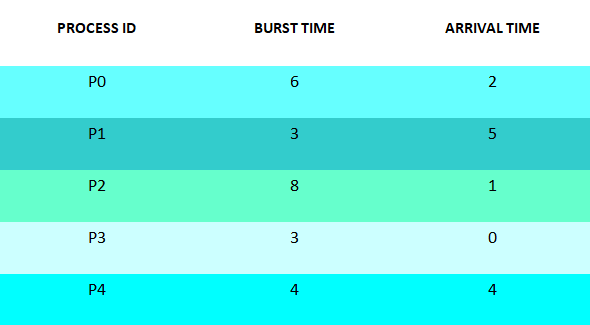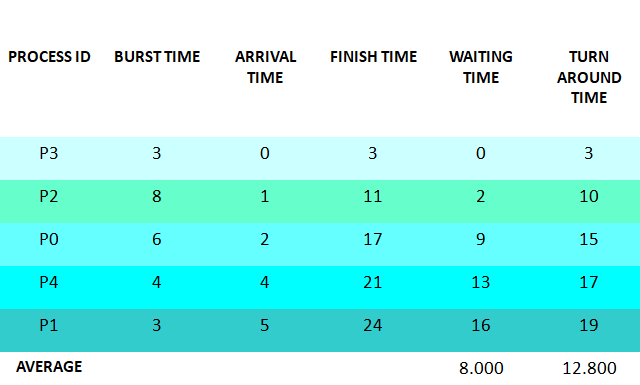How to Read the Cpu Burst Time of a Process in Java

Become this book -> Problems on Array: For Interviews and Competitive Programming
Algorithm
Example
Implementation Explanation
Implementation
Complexity
Advantages
Disadvantages
Reading time: 30 minutes | Coding time: 15 minutes
CPU Scheduling algorithms are used for scheduling different processes present in the set up queue with available resources (CPU cores) in an optimal way then that each and every process go executed by CPU. Scheduling algorithms are broadly classified into 2 chief types namely Preemptive and Non-preemptive.First Come Starting time Serve is an Non-preemptive Scheduling algorithm where each process is executed according to its inflow time.
Showtime Come Starting time Serve (FCFS) is as well known every bit First In First Out (FIFO) scheduling algorithm is the easiest and simplest CPU scheduling algorithm where the process which arrives get-go in the gear up queue is executed first past the CPU. New process is executed only when the electric current process is executed fully past the CPU.
Algorithm
- Step 1 : Input the number of processes required to exist scheduled using FCFS, flare-up time for each procedure and its arrival fourth dimension.
- Footstep ii : Using enhanced bubble sort technique, sort the all given processes in ascending gild according to arrival time in a ready queue.
- Step 3 : Calculate the Finish Time, Plow Effectually Time and Waiting Time for each process which in turn help to summate Average Waiting Time and Boilerplate Plow Around Fourth dimension required by CPU to schedule given set of procedure using FCFS.
- Stride 3.1 : for i = 0, Finish Fourth dimension T 0 = Arrival Fourth dimension T 0 + Burst Time T 0
- Step iii.ii : for i >= 1, Terminate Time T i = Burst Time T i + Finish Fourth dimension T i - 1
- Footstep three.three : for i = 0, Turn Around Time T 0 = Finish Time T 0 - Arrival Time T 0
- Step 3.4 : for i >= ane, Turn Effectually Time T i = Terminate Fourth dimension T i - Arrival Time T i
- Step 3.5 : for i = 0, Waiting Time T 0 = Turn Around Fourth dimension T 0 - Flare-up Time T 0
- Step 3.half-dozen : for i >= one, Waiting Time T i = Turn Effectually Time T i - Outburst Time T i - 1
- Step 4 : Process with less arrival time comes first and gets scheduled start by the CPU.
- Stride 5 : Calculate the Boilerplate Waiting Time and Average Plow Around Time.
- Stride 6 : Stop.
Example of First Come First Serve Algorithm
Consider the post-obit example containing five procedure with varied inflow fourth dimension.

- Step 1 : Processes get executed co-ordinate to their inflow fourth dimension.
- Pace 2 : Following shows the scheduling and execution of processes.
- Step two.1 : At showtime P3 arrives and get executed because its arrival time is 0. Its duration of execution is 0-3 seconds.
System Time : 0 Process Scheduled : P3 Waiting Time : 3 – 3 = 0 Turn Around Time : 3 - 0 = 3 - Step 2.2 : P2 arrives at time one sec during which CPU was decorated with Process P3.After completion of P3 , P2 is executed for duration iii-11 seconds.
System Time : 3 Process Scheduled : P3 P2 Waiting Time : 10 – 8 = two Turn Effectually Time : 11 – 1 = ten - Step two.iii : P0 arrives at time 2 sec just its execution is started at xi sec after complete execution of process P2 , for a duration 11-17 seconds.
System Fourth dimension : 11 Procedure Scheduled : P3 P2 P0 Waiting Time : 15 – half-dozen = nine Turn Around Fourth dimension : 17 – two = 15 - Step ii.4 : P4 arrives at time 4 sec but gets resource of CPU at 17th second for execution. Its execution period is 17-21 seconds.
Organisation Fourth dimension : 17 Process Scheduled : P3 P2 P0 P4 Waiting Time : 17 – 4 = 13 Turn Around Time : 21 – iv = 17 - Step two.v : Similarly P1 arrives at fourth dimension five sec just its execution gets started at fourth dimension 21st 2d and last for a menstruum 21-24 seconds.
Organization Time : 21 Process Scheduled : P3 P2 P0 P4 P1 Waiting Time : 19 – 3 = 16 Turn Around Time : 24 – 5 = 19 - Step 3 : Afterward scheduling of all provided processes :

Implementation Explanation
- Step 1 : In post-obit implementation, outset the number of processes and their corresponding arrival and burst timings are accepted by class method having post-obit method signature.
void getProcessData(Scanner input) - Step 2 : After accepting the requried input for processes another method firstComeFirstServeAlgorithm is chosen where, beginning the processes are sorted co-ordinate there respective inflow time in ascending order (less arrival time loftier priority) using enhanced bubble sort method in class method having following signature.
void sortAccordingArrivalTime(int[] at, int[] bt, Cord[] pid) - Stride three : Further, later getting sorted co-ordinate to inflow time finish, waiting, plow around timings are calculated in grade method having following signature.
void firstComeFirstServeAlgorithm() - Pace 3 : At final, the order of processes execution scheduled by FCFS scheduling algorithm is displayed every bit shown in Output Section.
Implementation
Following is the implementation of FCFS algorithm in Java:
import coffee.util.Scanner; public class FirstComeFirstServeCPUSchedulingAlgorithm { int burstTime[]; int arrivalTime[]; String[] processId; int numberOfProcess; void getProcessData(Scanner input) { Organisation.out.print("Enter the number of Procedure for Scheduling : "); int inputNumberOfProcess = input.nextInt(); numberOfProcess = inputNumberOfProcess; burstTime = new int[numberOfProcess]; arrivalTime = new int[numberOfProcess]; processId = new String[numberOfProcess]; String st = "P"; for (int i = 0; i < numberOfProcess; i++) { processId[i] = st.concat(Integer.toString(i)); Organization.out.print("Enter the burst time for Process - " + (i) + " : "); burstTime[i] = input.nextInt(); System.out.print("Enter the inflow time for Process - " + (i) + " : "); arrivalTime[i] = input.nextInt(); } } void sortAccordingArrivalTime(int[] at, int[] bt, String[] pid) { boolean swapped; int temp; String stemp; for (int i = 0; i < numberOfProcess; i++) { swapped = false; for (int j = 0; j < numberOfProcess - i - ane; j++) { if (at[j] > at[j + one]) { //swapping arrival time temp = at[j]; at[j] = at[j + 1]; at[j + 1] = temp; //swapping outburst time temp = bt[j]; bt[j] = bt[j + one]; bt[j + 1] = temp; //swapping process id stemp = pid[j]; pid[j] = pid[j + i]; pid[j + i] = stemp; //enhanced chimera sort swapped = true; } } if (swapped == false) { break; } } } void firstComeFirstServeAlgorithm() { int finishTime[] = new int[numberOfProcess]; int bt[] = burstTime.clone(); int at[] = arrivalTime.clone(); String pid[] = processId.clone(); int waitingTime[] = new int[numberOfProcess]; int turnAroundTime[] = new int[numberOfProcess]; sortAccordingArrivalTime(at, bt, pid); //calculating waiting & plow-effectually time for each process finishTime[0] = at[0] + bt[0]; turnAroundTime[0] = finishTime[0] - at[0]; waitingTime[0] = turnAroundTime[0] - bt[0]; for (int i = 1; i < numberOfProcess; i++) { finishTime[i] = bt[i] + finishTime[i - 1]; turnAroundTime[i] = finishTime[i] - at[i]; waitingTime[i] = turnAroundTime[i] - bt[i]; } float sum = 0; for (int due north : waitingTime) { sum += n; } bladder averageWaitingTime = sum / numberOfProcess; sum = 0; for (int north : turnAroundTime) { sum += north; } float averageTurnAroundTime = sum / numberOfProcess; //print on panel the lodge of processes scheduled using FirstComeFirstServer Algorithm System.out.println("FCFS Scheduling Algorithm : "); System.out.format("%20s%20s%20s%20s%20s%20s\north", "ProcessId", "BurstTime", "ArrivalTime", "FinishTime", "WaitingTime", "TurnAroundTime"); for (int i = 0; i < numberOfProcess; i++) { System.out.format("%20s%20d%20d%20d%20d%20d\n", pid[i], bt[i], at[i], finishTime[i], waitingTime[i], turnAroundTime[i]); } System.out.format("%80s%20f%20f\n", "Average", averageWaitingTime, averageTurnAroundTime); } public static void main(Cord[] args) { Scanner input = new Scanner(Organisation.in); FirstComeFirstServeCPUSchedulingAlgorithm obj = new FirstComeFirstServeCPUSchedulingAlgorithm(); obj.getProcessData(input); obj.firstComeFirstServeAlgorithm(); } } Input
Enter the number of Procedure for Scheduling : five Enter the burst fourth dimension for Process - 0 : half-dozen Enter the arrival time for Process - 0 : two Enter the burst time for Process - 1 : three Enter the inflow fourth dimension for Process - 1 : v Enter the burst time for Process - 2 : viii Enter the arrival time for Process - 2 : 1 Enter the burst time for Process - 3 : 3 Enter the arrival time for Process - 3 : 0 Enter the burst time for Process - 4 : 4 Enter the inflow time for Process - 4 : 4 Output
FCFS Scheduling Algorithm : ProcessId BurstTime ArrivalTime FinishTime WaitingTime TurnAroundTime P3 3 0 3 0 3 P2 8 1 11 2 10 P0 6 ii 17 9 15 P4 4 4 21 13 17 P1 3 v 24 sixteen nineteen Average eight.000000 12.800000 Complexity of FCFS algorithm
The time and space complication for Kickoff Come First Serve Algorithm :
- Worst case time complication:
Θ(due north2) - Average case fourth dimension complexity:
Θ(n2) - Best case time complexity:
Θ(northward) - Space complexity:
Θ(1)
where N is the number of processes.
Advantages of FCFS algorithm
- It is one of the simplest grade of CPU Scheduling Algorithm.
- It is easy to implement.
Disadvantages of FCFS algorithm
- The Average Waiting Time is high compared to other CPU Scheduling Algorithms.
- FCFS is an Non-Preemptive algorithm where information technology locks the resources till the current process execution is complete.
- Hence processes situated at last of ready queue having depression burst/execution time have to wait more because of high burst/execution time located at starting of set up queue mainly known as trouble of starvation.
- Resource Utilization in parallel is not possible in FCFS.
- Not a platonic algorithm for procedure scheduling.
With this article at OpenGenus, y'all must have a consummate idea of First Complete First Serve scheduling algorithm. Enjoy.
Learn more than:
- Types of CPU Scheduling algorithms by Kshitiz Saini at OpenGenus
- Shortest Chore Outset CPU Scheduling algorithm by Kshitiz Saini at OpenGenus
Source: https://iq.opengenus.org/first-come-first-serve-cpu-scheduling/
0 Response to "How to Read the Cpu Burst Time of a Process in Java"
Post a Comment